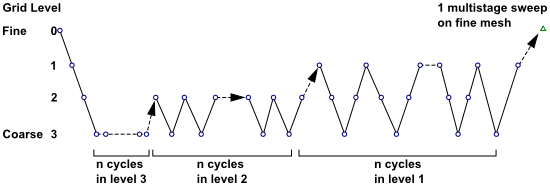FMG initialization utilizes the Ansys Fluent FAS Multigrid technology (see Full-Approximation Storage (FAS) Multigrid) to obtain the initial solution. Starting from a uniform solution (after performing standard or hybrid initialization or reading data), the FMG initialization procedure constructs the desirable number of geometric grid levels using the procedure outlined in Full-Approximation Storage (FAS) Multigrid. To begin the process, the initial solution is restricted all the way down to the coarsest level. The FAS multigrid cycle is then applied until a given order of residual reduction is obtained or the maximum number of cycles is reached. The solution is then interpolated one grid level up and the FAS multigrid cycle is applied again between the current level all the way down to the coarsest level. This process will repeat until the finest level is reached. The FMG initialization iteration is illustrated in Figure 23.13: The FMG Initialization.
Since FMG initialization does most of the work on coarse levels, this initialization procedure is computationally inexpensive and, for large problems, a good initial solution can be obtained in a fraction of the time spent to converge on a final solution. Note that FMG initialization can be used with the pressure-based and density-based solvers.
When FMG initialization is started, the algorithm will perform the following steps:
Records the current solver selection and all current solver parameters.
Switches from the selected solver to the density-based explicit formulation.
Performs one FMG iteration using the FMG parameters given in the text command interface (see below).
Switches back to the initially selected solver and resets all solver parameters back to the original solver settings.
In the FMG iteration, the Euler equations for inviscid flow are solved using first order-discretization to obtain the approximate solution. If species are present, then the FMG initialization will solve the species equations. While turbulence equations or any other transport scalars are not solved during the FMG initialization cycles, their values will be updated once after the final FMG sweep on the fine mesh using the latest velocity and pressure fields



